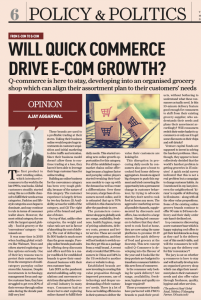Flipkart’s Big Billion Day Sale has once again sparked the discussion of e-commerce in India. Has e-commerce truly arrived? Is it really viable? Are they really ready to service the consumer? Is it going to take off?
There were all kinds of experiences being shared on social media, from overpricing to under stocking. But my feeling is that it was a planned strategy, along the lines of earlier successes which manipulated Indian consumers.
In 2010, I launched my e-commerce venture. That was the time when Flipkart had started selling electronics online. Snapdeal was only selling discount coupons. My platform offered almost everything my customers demanded, from cars to cinema tickets. We were not offering great deals but a great convenience,with everything at the best possible prices. When our customers started telling us how Flipkart was offering laptops and cameras at much lower prices and that Snapdeal was offering meals in fine dining places at 60% discount, we started investigating their model, and began talking to brands and restaurants. We discovered that most of these deals were listed at marked-up MRPs and then were displayed as fabulous discounts. We shared these facts with our customers to close our sales, but these guys played on a much larger scale, and it wasn’t possible for us to expose every transaction. By-and-large Indian consumers can be fooled by displaying big discount offers. But we found this unethical! Consumers looking for convenience and assurance stayed with us, however a large number of people enticed by attractive-looking deals started getting sucked into aggressive marketing campaigns.
My view is that the overall e-commerce space in India has been seeded on the wrong foundation.Unfortunately,global venture capital firms have endorsed this model by funding billions to cover the trading losses generated by these ventures to lure the consumers. The only beneficiaries are consumers and brands selling their products. Recent boycott threats by some of the consumer goods brands of Flipkart has shown very clearly that undercutting of their prices by them has started affecting their business in the brick-and-mortar space.
In western markets, e-commerce was launched with the basic principle of building shopping assurance and convenience to the consumers.Since the consumers in those markets were willing to pay for that service, e-commerce ventures did not have to go through the trading loss cycle. They had to fund the scale-up cycle to make their overall operations viable across the business.
The Indian consumer is different,always looking for deals and shall continue to do so! Their loyalties will always be linked to discounts. The Indian consumer is used to a below-average quality of service and in fact don’t value great service and is obviously not willing to pay for that at all. Although all these big brands in e-commerce, Flipkart, Snapdeal, Amazon etc., are scaling up their consumer base and sales transactions, they are doing this largely due to unsustainable discounts they offer by sacrificing trading margins.
On top of that, they also have to fund a basic level of logistics costs to deliver within a promised time delivery time.
That means the higher the sale higher the loss.
I don’t think this strategy is giving them any visibility of reducing this loss in the near terms.
The key challenge will be to build purchase efficiency and use these to offer the discounts. The cost of logistics can also be lowered by using the existing infrastructure for scaled up business.
In the current business model,reducing this loss is looking impossible as of now, unless these companies work towards further refinement of their so called market place model with more decentralization and a realistic approach. The approach which will bring e-commerce and brick-and-mortar retailers to work together and cooperate to service a common consumer! That is why I feel there is a hope for a brick-and-mortar retailer to run a profitable e-commerce business.



